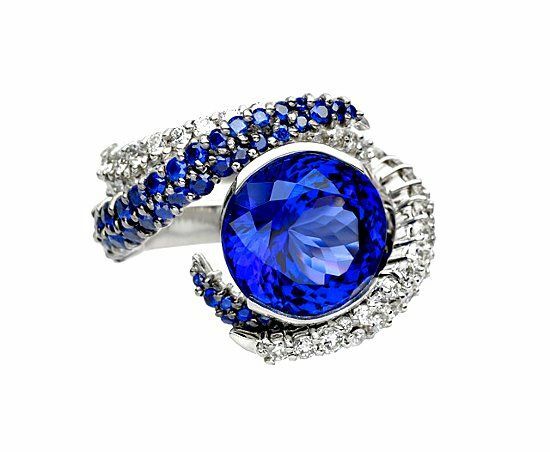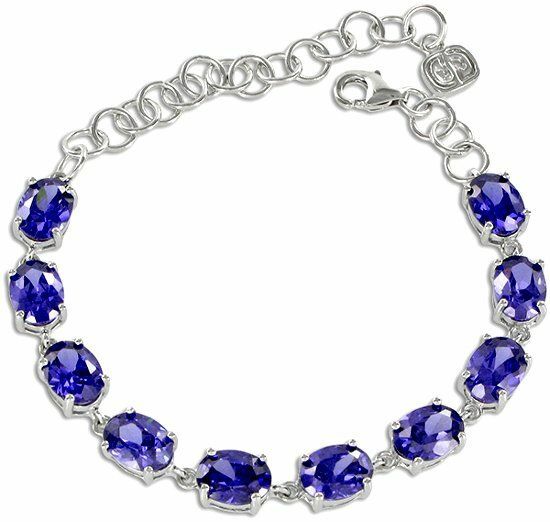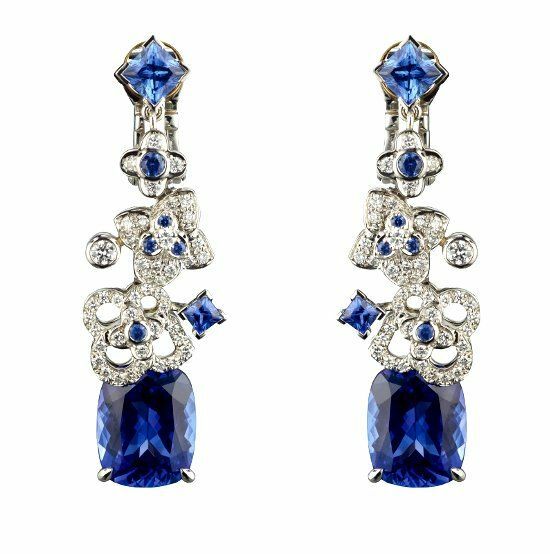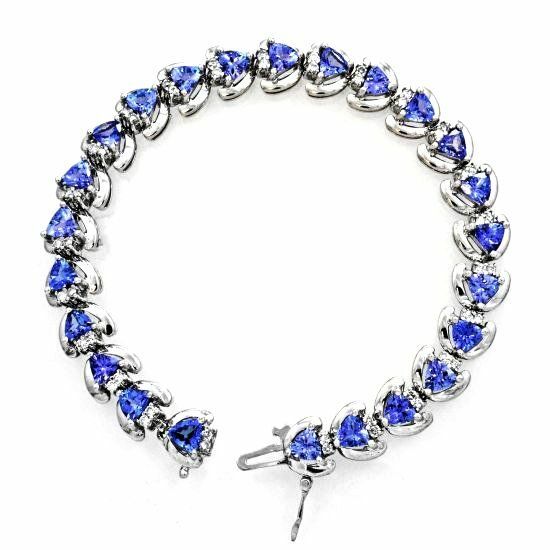
Tanzanite is an expensive jeweler stone, which, due to its unique properties, extraordinary beauty and rarity, has become one of the elite gemstones.
Tanzanite is called the miracle of Africa and the personification of a mysterious continent - the only place where this beautiful rare stone is mined. It combines the blue of the southern African sky, purple-purple color of the African night, the brown-yellow shade of the African savanna and the bright green foliage of its palms.
History of stone
Tanzanite refers to one of the youngest precious stones on Earth, its history of usityvaet less than half a century.
It was discovered at the foot of Mount Kilimanjaro( Tanzania) only in 1967.According to one of the versions, the first discoverer of tanzanite was the local resident Ali Djuyavati, and on the other - the Portuguese jewel seeker Manuel De Souz. There is also a version that tanzanite was completely accidentally found by African shepherds who brought a stone to a Portuguese searching for rubies in these places.
The discovery of tanzanite was facilitated by a fire that exposed the bottom layer of the soil, resulting in the appearance of beautiful blue crystals on the surface of the earth. Initially, this finding was not given the proper value, taking it for ordinary glass, but when the minerals were carefully studied and examined, scientists came to the conclusion that this is a new stone, which has not been studied before and is unknown, being a kind of zoisite.
Literally a year later, in 1968, during his official presentation, tanzanite was named the most beautiful blue gemstone found in the last 2000 years.
But the real world fame was brought to the stone by the famous American jewelry company "Tiffany &Co, which created with tanzanite a fine collection of exclusive jewelry. By the way, the idea of the name of the stone belongs to the company "Tiffany &Co "-" tanzanite ", as a derivative word from the name of the only country in the world where this amazing stone is mined - Tanzania.
In less than 50 years, tanzanite has gained incredible popularity in the world. Its price grows every day, in proportion to how its world stocks decrease. And they, according to experts, given the speed and scale of production, enough for a maximum of 15-20 years. So very soon Tanzanite promises to be the rarest exhibit.
to contents ^Description of mineral
Tanzanite is fascinating and amazing with its extraordinary beauty, crystal transparency and unique brilliance.
Its blue-lavender color is unique, and the special charm of the stone is attributed to the "alexandrite effect" - trichroism, due to which in different lighting and under different angles, tanzanite is painted in three different shades: saturated dark blue with violet tint, yellow-brown or greenish andpurple and purple. This color game makes the stone simply unforgettable.
True, natural blue tanzanites are very rare in nature. In 90% of the cases, the initial color of the stone is brown. Only after a short heat treatment, he acquires the most famous blue-lavender saturated shade.
to contents ^Chemical composition and physical properties of the stone
Tanzanite is a species of zoisite in its species.
The chemical composition is a silicate of aluminum and calcium. Its chemical formula is Ca2Al3 [O, OH /SiO4/ Si2O7].In addition to calcium and aluminum, tanzanite contains impurities of chromium and vanadium, which color the stone in blue and violet.
Tanzanite crystals are brittle, transparent, translucent, with glass shine and high degree of pleochroism( trichroism).In one crystal of tanzanite, blue, purple-lilac or violet shades, brown, green or yellow, can be combined.
The most expensive are the specimens of stone, in which daylight prevails a deep blue shade with bright violet tints, and under artificial illumination - red-purple.
In nature, such stones are extremely rare, only in those places where the crystals of tanzanite come to the surface and are heated for a long time by the hot African sun. All other specimens of tanzanite extracted from African bowels have yellow-brown or green hues, which are replaced by blue only when heated to a temperature of 600 ° C.
Tanzanite is a fairly hard, though fragile mineral. According to experts, its Mohs hardness reaches 6.5-7 units, and its density is 3.1-3.5 g / cm3.
to contents ^Tanzanite deposits
To date, only one tanzanite deposit is known - the Merelani plateau, which is located in Tanzania in the heart of the African continent, in the foothills of Kilimanjaro.
to the table of contents ^The healing properties of the
mineral Lithotherapists believe that due to its surprising color and the presence of sky-blue and sapphire-blue hues, tanzanite is able to have a beneficial effect on the eyes:
- to increase visual acuity;
- to lower ocular pressure;
- remove the voltage after working on the computer.
It is believed that tanzanite has a positive therapeutic effect with:
- supercooling;
- fever;
- diseases of the back and spine;
- acne.
Magic properties of tanzanite
Despite its fairly young age for a stone, tanzanite has already managed to acquire the glory of a powerful magical stone.
- In America, it is considered a symbol of happiness and prosperity, love and luxury.
- In Europe, tanzanite is considered a talisman of commercial success.
- In Africa, tanzanite is credited with the property of attracting the attention of the opposite sex.
- Modern magicians recommend tanzanite as a family charm and are advised to give it on the 24th anniversary of a joint life.
Tanzanite and the zodiac signs
Like many other blue stones, astrologers recommend ornaments with tanzanite watermarks of the zodiac - Pisces, Cancers and Scorpions.
At the same time, this stone is perfect for Aries, becauseit is believed that Tanzanite is able to give the necessary wisdom and composure.
to the table of contents ^Application of the gem
- Due to its beauty, uniqueness and rarity, tanzanite is successfully used in jewelry, replacing traditional precious stones in collections of famous jewelry houses. However, given the high degree of its fragility, designers are constantly looking for new ways to fix and protect this stone from bumps and possible scratches. Usually tanzanite is cut using a diamond or a mixed cut.
- Another area of application of stone is collecting. Given the limited reserves of tanzanite, beautiful large specimens of this stone are highly valued by collectors and jewelry lovers. Their price can go up to 2 thousand dollars or more for one carat. Experts consider such acquisitions as reliable investments.
Interesting facts about the stone
- The world's largest unrestricted tanzanite is a blue-violet aggregate weighing almost 17,000 carats. Its size is: 220 mm x 70 mm x 80 mm. This stone was named after the second highest peak of the Kilimanjaro mountains - "Mavenzi".It is so unique that its price has not been determined. So this is an invaluable stone.
- The largest faceted tanzanite is a specimen, which is now stored in the museum of the Smithsonian Institution. Its weight is 122.7 carats.
- No less beautiful large crystals of tanzanite can be seen in the USA, in Los Angeles - in the Museum of Natural History. These are blue and blue stones measuring 4.2 and 9.5 cm.
- Famous jewelers from all over the world today represent tanzanite in their collections. And the designers of The Stuart Weitzman and Le Vian even encrusted them, along with diamonds, with elite shoes made of silver leather.
- Jewelry with tanzanite is part of the jewelry collection of the famous film star Elizabeth Taylor.
- The most famous tanzanite was the stone, which was inlaid with the decoration of the protagonist of the film "Titanic", because this gorgeous blue gem played the role of a diamond.
How to distinguish natural tanzanite from forgery
Given the huge rarity of tanzanite and its high cost, in the jewelry market, its fakes - imitations of glass, synthetic forsterite, and also doublets consisting of glass and tanzanite or blue syntheticspinels.
Determine the fake can be, knowing the properties of tanzanite and its features:
- Pleohroism( trichroism), called "alexandrite effect."This is the main distinguishing feature of tanzanite. This property is not confused with anything. Only tanzanite is capable of shimmering in three different shades depending on the lighting and angle of view.
- Clean stone. Tanzanite is a clean and transparent gem. It is characterized by the absence of natural inclusions.
- Naturalness of color. Despite the rich color gamut, the color of tanzanite should not look artificially bright.
- No glow due to ultraviolet light. Imitations of tanzanite, made from synthetic forsterite, will give a bright orange glow under the action of short-wave ultraviolet radiation and a greenish-yellow glow under the action of a long-wave, while tanzanite will remain completely inert.
- Change in color in water. When immersed in water, natural tanzanite brightens at the edges, while the glass remains uniformly colored throughout the perimeter.
- High cost. A low price is the main sign that you are being offered a fake.
Stone care
Tanzanite is an unusually fragile stone and requires special care in the care.
- Tanzanite is categorically prohibited from ultrasonic, mechanical, acidic or steam cleaning.
- Jewelry with tanzanite or a collection of stones should be kept separately from any other stones and ornaments.
- Tanzanite can only be washed with a soap solution.
- The stone must be protected from sudden changes in temperature.
Jewelry with tanzanite are among the elite and it is recommended to wear them only on special occasions.
to the table of contents ^Photos of tanzanite and jewelry from it






